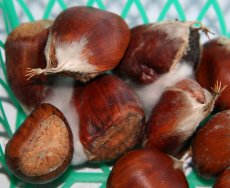 |
||||||
|
| ||||||
|
Storing Chestnuts For Many Weeks
Washington Chestnut Company has been performing chestnut storage studies for
over a decade to help consumers extend the storage of fresh chestnuts. The
storage tests have proved to be a great investment. Chestnuts without proper
handling usually will not store for more than 3 weeks. In our latest
storage test we took some chestnut with the first signs of molds/fungus growth
and processed them to achieve stable storage of chestnuts until late December
from chestnuts harvested in October and early November without the use of
magic.

These chestnuts are molding because they were not processed properly after harvest Here are few things were tried but were not satisfied with the results: 1. Hot water bath warm enough to kill some fungus/models but not hot enough to kill the chestnuts 2. A bleach bath 3. Freezing Of these three options the bleach bath gave the best results with a resulting storage life of 4 weeks. We felt 4 weeks of storage was not good enough so we continued to try to find a better process. The hot water bath did not help at all, maybe even causing a shortened storage life. Freezing changed the chestnut texture to a mushy mess, making the chestnuts not so good for eating. After trying many different possible solutions to the storage life extension goal, we can suggest partially drying the chestnuts and then placing the chestnuts in a sealed plastic bag in the fridge. The partial drying is done by laying out the chestnuts in a single layer on a cookie sheet at room temp until the chestnuts have lost 25 percent of their weight. Put the chestnuts in a sealed container/plastic bag into the fridge. Check on the chestnuts every 10 - 14 days and remove any chestnuts turning black or developing molds. These chestnuts are in perfect condition because they were processed properly after harvest We have a ecommerce web site at www.BuyFreshChestnuts.com for purchasing fresh chestnuts. |
|
Contact Information: |
||||
| © 2006 - 2021 Washington Chestnut Company All Rights Reserved. | ||||||